ホーム > 観光・名産 > 観光・レジャー > 観光・名所 > 観光情報ひろば湘南 > Course to tour historic sites in the Tokaido post town of Hiratsuka-juku
更新日:2026年1月13日
ここから本文です。
Course to tour historic sites in the Tokaido post town of Hiratsuka-juku
湘南地域のモデルコースをご紹介しています。
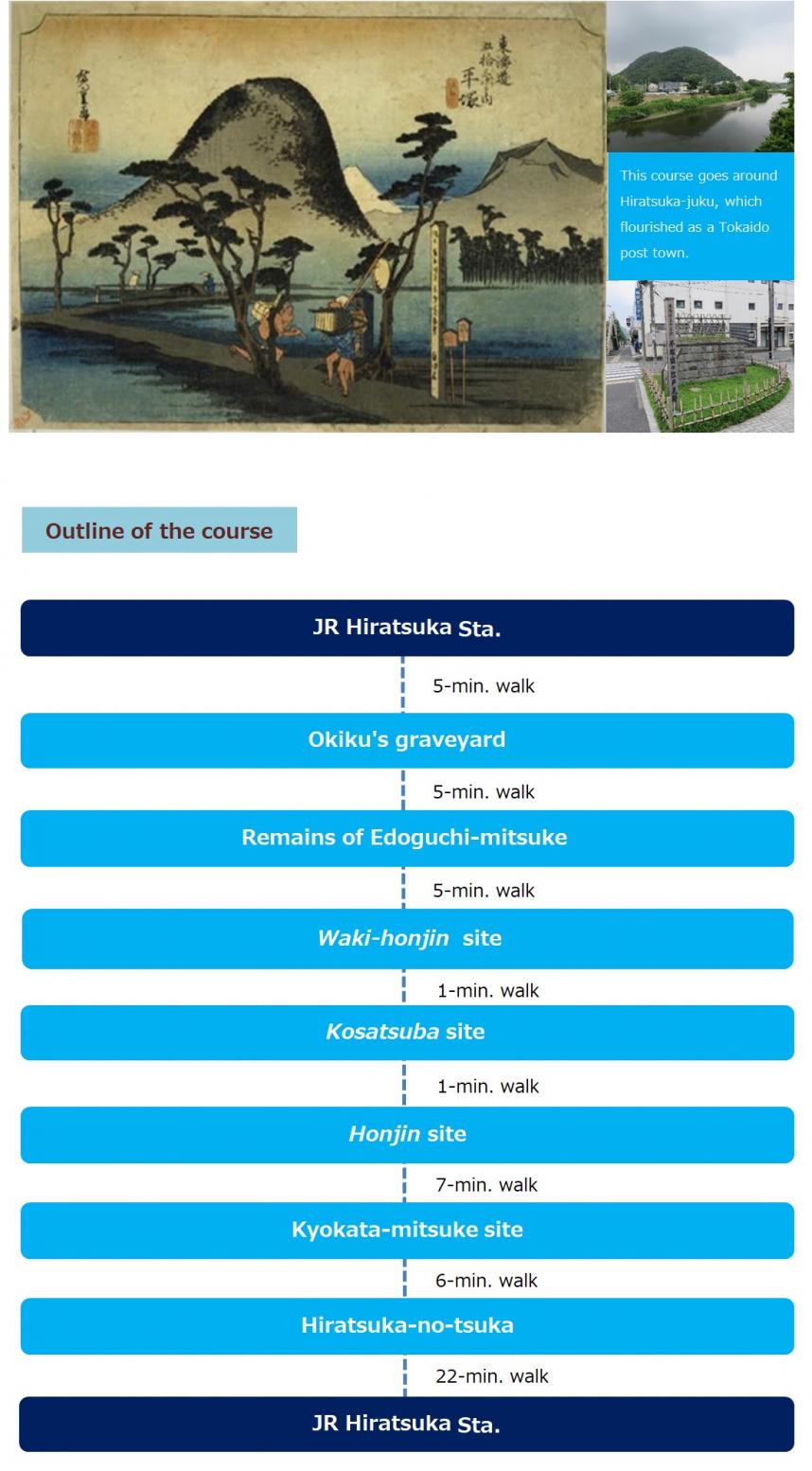
The Tokaido was the largest major road of the Edo period, connecting Edo and the Kyoto-Osaka area.
There were 53 post stations between Edo and Kyoto. Many people traveled the road for official and commercial business as well as sightseeing, from daimyo (feudal lords) in their processions to the general public.
Construction of the Tokaido was started by Tokugawa Ieyasu in 1601, but as traffic gradually increased, the development of post stations was expanded.
Approaches were built at post stations to indicate the entrance, along with notice boards for official announcements (such as law proclamations); inns officially designated as lodging for court nobles, daimyo, and government officials of the shogunate; and inns for ordinary travelers.
There were nine post towns on the Tokaido in Kanagawa Prefecture: Kawasaki, Kanagawa, Hodogaya, Totsuka, Fujisawa, Hiratsuka, Oiso, Odawara, and Hakone. This course focuses on Hiratsuka-juku.
*The description of this model course is accurate as of August 2018.
*The woodblock print is Hiratsuka: Footpath Between Rice Paddies by Utagawa Hiroshige from the series Fifty-three Stations of the Tokaido (from the National Diet Library Digital Collections).
Course guide
JR Hiratsuka Station
▼ approx. 5-min. walk ▼
1. Okiku’s graveyard
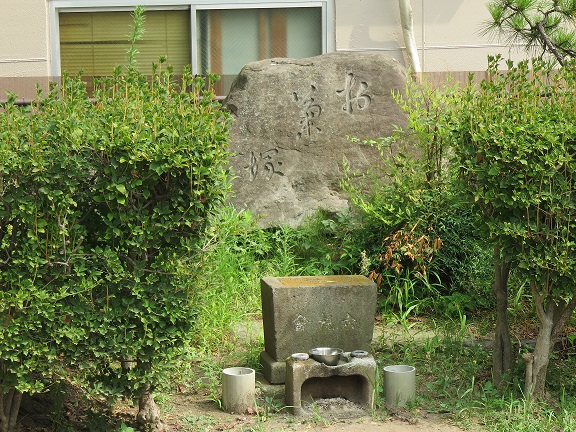 (Okiku’s graveyard)
(Okiku’s graveyard)
This course goes around Hiratsuka-juku, the seventh post town of the 53 stations of the Tokaido.
Before visiting the historic sites of Hiratsuka-juku, you will stop by Okiku’s graveyard, about a five-minute walk from Hiratsuka Station.
Okiku’s graveyard is inside Beniyacho Park and is the resting place of Okiku, known widely as the heroine of the Edo-period ghost story The Dish Mansion at Bancho.
In Hiratsuka, it is said that Okiku, who was the only daughter of a Hiratsuka-juku official, met a violent death at the hand of her employer despite her innocence, and her remains were buried here.
▼ approx. 5-min. walk ▼
2.Remains of Edoguchi-mitsuke
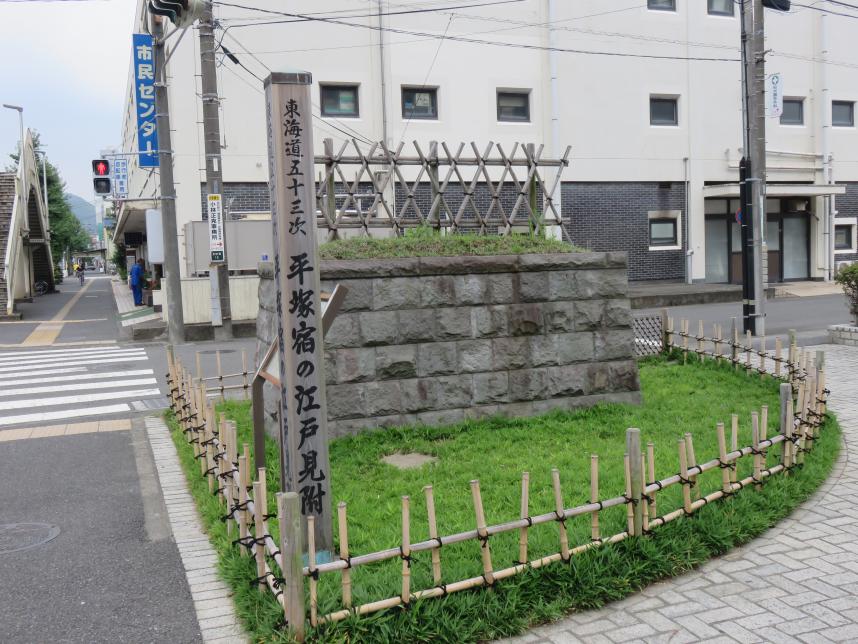 (Remains of Edoguchi-mitsuke)
(Remains of Edoguchi-mitsuke)
Hiratsuka-juku spanned roughly one kilometer from the Edo-mitsuke, which was the entrance on the Edo side, to the Kyokata-mitsuke on the Kyoto side along the old Tokaido, which ran from east to west.
Modern Hiratsuka-juku was established in 1601 when Tokugawa Ieyasu constructed the Tokaido, and was the seventh post station counting from Nihonbashi.
It developed as a key transportation point with a heavy flow of goods and people from times of old, and it is said that there were more than 200 buildings making up the townscape through the Edo period.
The road was crowded with many people, including daimyo accompanied by their vassals and people hauling cargo.
You’ll find the remains of the Edoguchi-mitsuke about a five-minute walk from Okiku’s graveyard.
They were restored based on a photograph an Italian ambassador in the early Meiji Period took back with him to Italy.
〔See the map of Remains of Edoguchi-mitsuke〕
▼ approx. 5-min. walk ▼
3.Waki-honjin site
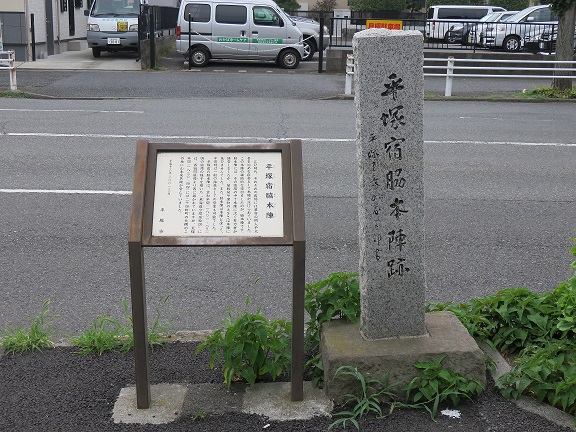 (Waki-honjin site)
(Waki-honjin site)
Post towns in the Edo period had honjin where government officials and daimyo lodged, and waki honjin, which were subsidiary inns used by their attendants.
During normal times, ordinary people were allowed to stay at the waki-honjin.
The only waki-honjin in Hiratsuka-juku was located here. Today there is an informational sign showing where it stood.
▼ approx. 1-min. walk ▼
4.Kosatsuba site
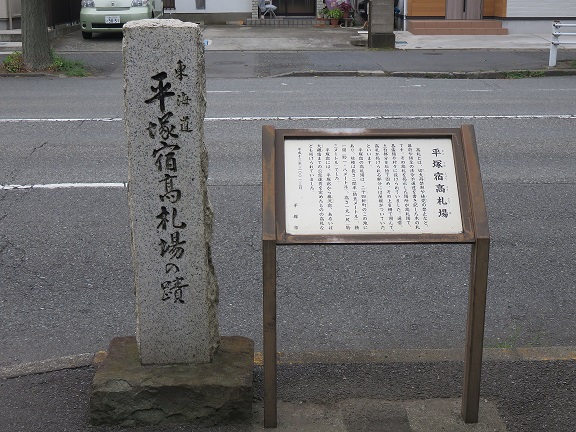 (Kosatsuba site)
(Kosatsuba site)
The kosatsuba was where notices of laws and ordinances by the shogunate or feudal lord were posted. They were put up in villages as well as post towns.
The kosatsuba in Hiratsuka-juku also displayed information such as the official fares to get to neighboring post stations like Fujisawa-juku and Oiso-juku.
Today there is an informational sign showing where it stood.
▼ approx. 1-min. walk ▼
5.Honjin site
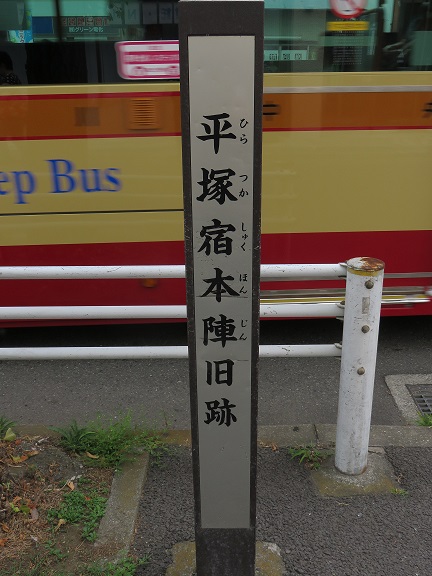 (Honjin site)
(Honjin site)
Honjin were large luxury inns in post towns on the Tokaido where daimyo going to or from their posts in Edo, as well as court nobles and government officials, stayed.
Today there is an informational sign showing where it stood.
▼ approx. 7-min. walk ▼
6.Kyokata-mitsuke site
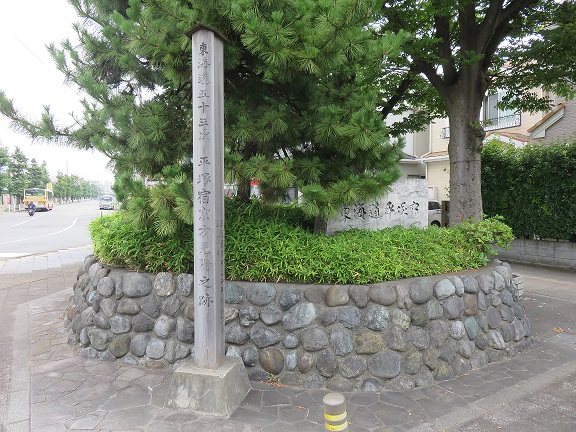 (Kyokata-mitsuke site)
(Kyokata-mitsuke site)
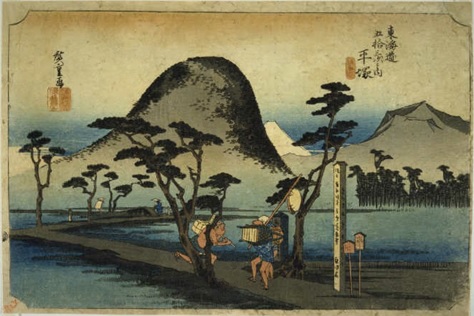
(Hiratsuka: Footpath Between Rice Paddie from the series Fifty-three Stations of the Tokaido)
The precise location of the Kyokata-mitsuke, which was the western entrance to Hiratsuka-juku, is unknown due to air raids and later town planning, but a monument has been placed here based on tradition.
The woodblock print Hiratsuka: Footpath Between Rice Paddies by Utagawa Hiroshige is said to depict the view from around here. It shows Mt. Koma in the background, with a Tokaido footpath and the Hanamizu River in the foreground. Behind Mt. Koma is a snow-covered Mt. Fuji, and to the right is Tanzawa.
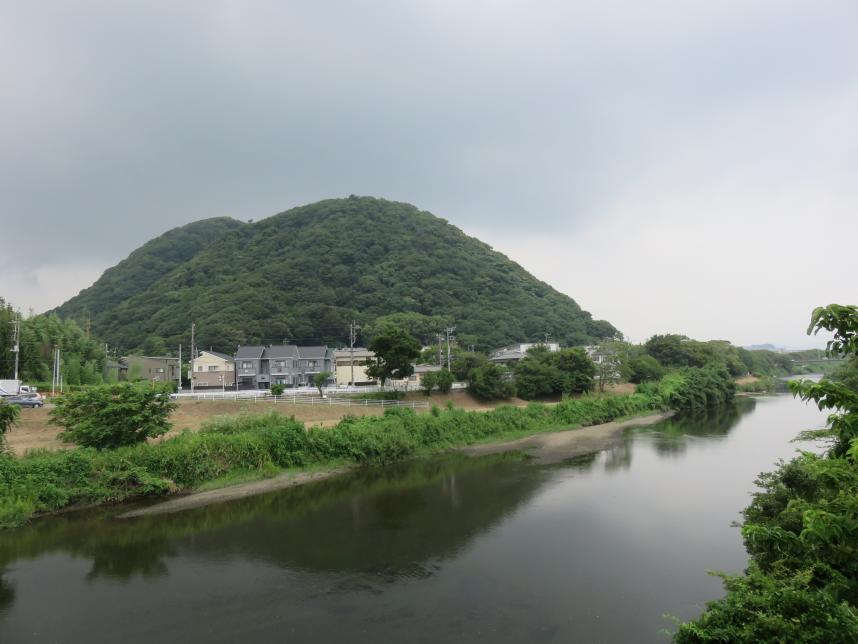 (Mt.Koma)
(Mt.Koma)
If you walked a little downstream along the Hanamizu River from the Kyokata-mitsuke site, you would have a clear view of Mt. Koma.
Unfortunately, neither Mt. Fuji nor Tanzawa were visible on the day this photograph was taken. However, this unchanging scenery brings a feeling of awe as you stand in the same place where travelers once hurried west.
The road to Oiso-juku is actually flat, but at first glance, it looks as though Mt. Koma would block your path when you stand here.
It is said that travelers used to stop at the inn in Hiratsuka-juku and stay for the night, thinking that they would have to climb the mountain to get to Oiso.
〔See the map of Kyokata-mitsuke site〕
▼ approx. 6-min. walk ▼
7.Hiratsuka-no-tsuka
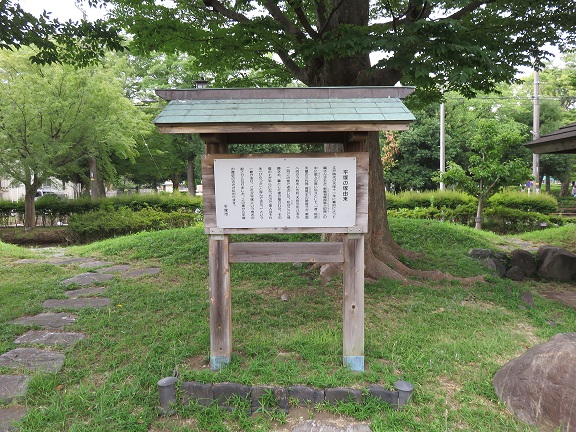
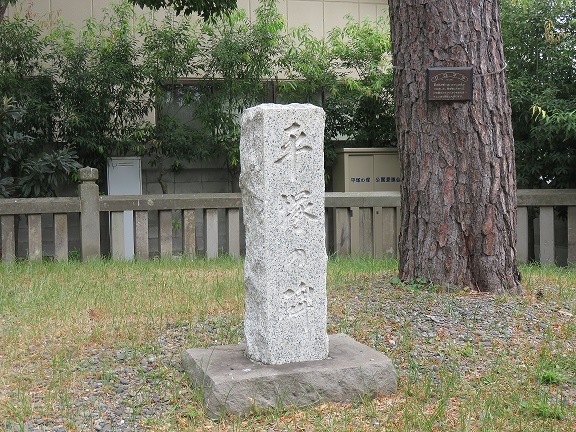 (Hiratsuka-no-tsuka)
(Hiratsuka-no-tsuka)
The Hiratsuka-no-tsuka stele is located in the Hiratsuka-no-tsuka Green Space slightly off the old Tokaido.
According to one theory, this is where the name “Hiratsuka” comes from.
According to a legend recorded in a book compiled in the Edo Period, Taira no Masako, a descendant of Emperor Kanmu, died here in the middle of the Heian Period, and the top of the mound made when burying her casket was flat. Based on this, the villagers called it “hiratsuka” (“flat mound”), which became the name of the area.
There are various theories on the origins of the name, but regardless of where it came from, the ancient history of Hiratsuka is palpable when you walk the streets.
〔See the map of Hiratsuka-no-tsuka〕
▼ approx. 22-min. walk ▼
JR Hiratsuka Station
Other information on Hiratsuka City
There are many other things to see in Hiratsuka City besides the sites presented in this model course. Please visit the links below for details.
このページに関するお問い合わせ先
企画調整部 商工観光課
電話 0463-45-3193
このページの所管所属は 湘南地域県政総合センターです。